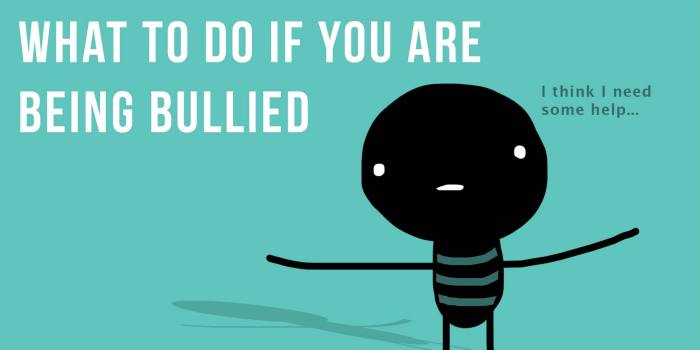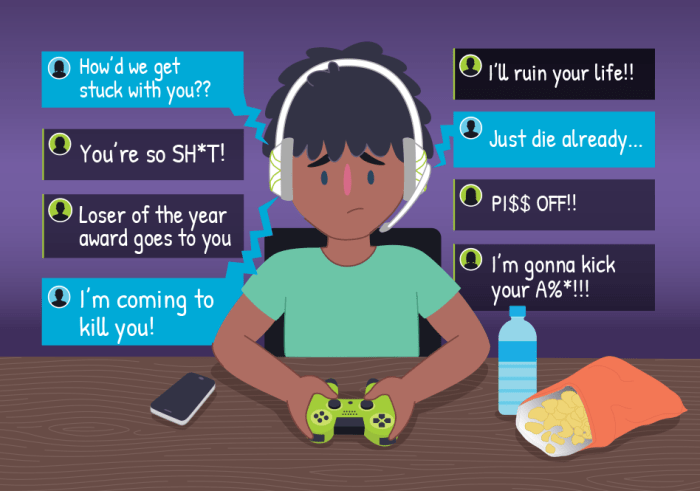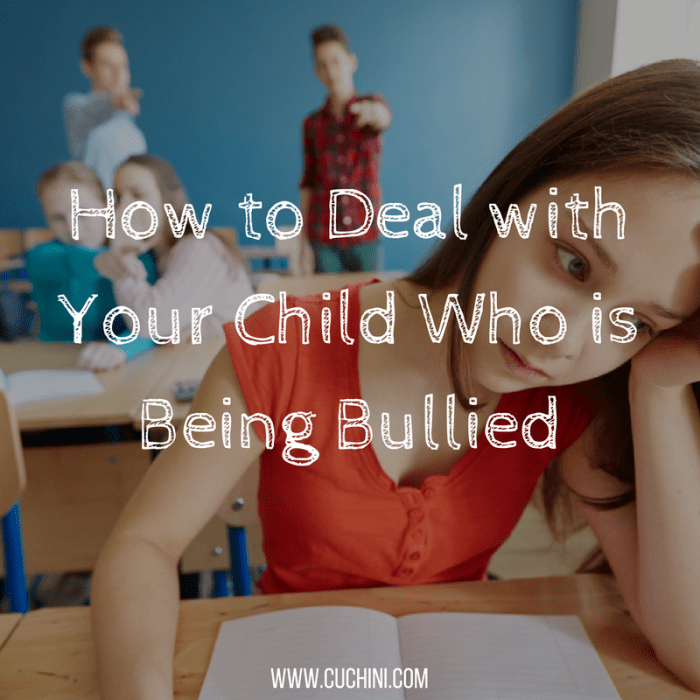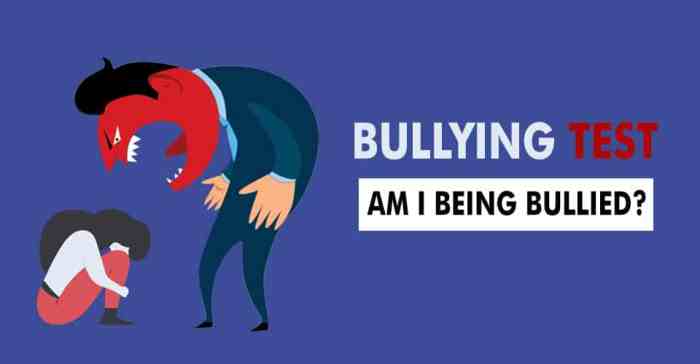Am i being bullied quiz – Take our “Am I Being Bullied?” quiz to assess your experiences and determine if you may be a victim of bullying. This interactive tool provides insights into the different forms of bullying, their impact, and strategies for coping and seeking support.
Bullying is a prevalent issue that can have lasting consequences. Understanding the signs and symptoms of bullying is crucial for both victims and those who witness it. Our quiz empowers you to recognize and address bullying behavior, whether it’s happening to you or someone you know.
Overview of Bullying

Bullying refers to intentional and repeated aggressive behavior that creates an imbalance of power between the bully and the victim. It encompasses a wide range of behaviors, including physical, verbal, social, and cyberbullying.
Bullying is a prevalent issue that affects individuals of all ages and backgrounds. Research suggests that approximately one in five students experience bullying, with higher rates among marginalized groups such as LGBTQ+ youth and students with disabilities.
Impact of Bullying
Bullying can have significant consequences for both the victims and the bullies. Victims may experience physical injuries, emotional distress, academic difficulties, and social isolation. In severe cases, bullying can lead to depression, anxiety, and even suicide.
Bullies, on the other hand, are more likely to engage in delinquent behavior, substance abuse, and violent acts later in life. They may also experience difficulty forming healthy relationships and maintaining employment.
Types of Bullying

Bullying is a serious problem that can have lasting effects on victims. There are many different types of bullying, each with its own unique characteristics.
Some of the most common types of bullying include:
Physical Bullying
Physical bullying is any type of physical harm or violence inflicted on a victim. This can include punching, kicking, shoving, or any other type of physical assault.
Verbal Bullying
Verbal bullying is any type of verbal abuse or harassment directed at a victim. This can include name-calling, insults, threats, or any other type of hurtful or degrading language.
Social Bullying
Social bullying is any type of behavior that is intended to isolate or exclude a victim from social groups or activities. This can include spreading rumors, gossiping, or excluding someone from social events.
Wondering if you’re being bullied? Take our quick quiz to find out. If you’re feeling overwhelmed, don’t hesitate to reach out for help. Check out our comprehensive guide to the NR 601 Final Exam 2023 for additional support and resources.
Remember, you’re not alone. Our quiz and resources are here to help you understand and address bullying.
Cyberbullying
Cyberbullying is any type of bullying that takes place online or through electronic devices. This can include sending hurtful or threatening messages, posting embarrassing photos or videos, or creating fake profiles to harass someone.
Signs and Symptoms of Bullying: Am I Being Bullied Quiz
Bullying can have a significant impact on the physical, emotional, and mental well-being of victims. Recognizing the signs and symptoms of bullying is crucial for providing support and intervening effectively.
The following are common signs that someone may be experiencing bullying:
Physical Signs
- Unexplained bruises, cuts, or other injuries
- Torn or damaged clothing
- Frequent headaches or stomachaches
- Changes in sleep patterns
- Difficulty concentrating or paying attention
Emotional Signs
- Withdrawal from friends and family
- Increased irritability or anger
- Sadness or depression
- Anxiety or fear
- Loss of interest in activities
Social Signs
- Avoidance of certain places or people
- Difficulty making or maintaining friendships
- Changes in behavior or personality
- Increased isolation or loneliness
- Increased risk-taking behaviors
Academic Signs
- Decline in grades
- Difficulty concentrating in class
- Increased absences from school
- Avoidance of extracurricular activities
- Loss of interest in learning
It is important to note that not all individuals who experience bullying will exhibit all of these signs. Some may only show a few symptoms, while others may have more severe or persistent issues. If you suspect that someone is being bullied, it is essential to reach out and offer support.
Encourage them to talk about what they are going through and provide them with resources for help.
Effects of Bullying

Bullying can have devastating effects on victims, both in the short and long term. The consequences can be psychological, emotional, and physical, impacting various aspects of a person’s life.
Psychological Effects
Bullying can severely damage a victim’s self-esteem and confidence. It can lead to feelings of shame, guilt, and worthlessness. Victims may experience anxiety, depression, and even suicidal thoughts. Bullying can also impair cognitive functioning, making it difficult for victims to concentrate and perform well academically.
Emotional Effects, Am i being bullied quiz
Bullying can evoke intense emotional distress. Victims may feel isolated, lonely, and betrayed. They may become withdrawn and avoid social situations. Bullying can also lead to anger, resentment, and a desire for revenge.
Physical Effects
In some cases, bullying can result in physical harm. Victims may suffer from headaches, stomachaches, and other physical ailments. They may also experience sleep disturbances and fatigue. In severe cases, bullying can lead to injuries or even death.
Prevention and Intervention
Bullying is a serious problem that can have lasting effects on victims. However, there are many things that can be done to prevent and intervene in bullying.
Prevention
There are a number of things that can be done to prevent bullying in schools and communities. These include:
- Creating a positive school climate.Schools that have a positive school climate are less likely to have bullying. This means creating a school environment where students feel safe, respected, and supported.
- Teaching students about bullying.It is important to teach students about bullying so that they can recognize it and know how to respond to it. This can be done through classroom lessons, assemblies, or other activities.
- Encouraging students to report bullying.Students need to know that they can report bullying without fear of retaliation. Schools should have clear policies and procedures for reporting bullying, and they should make sure that students know how to use them.
- Providing support for students who are bullied.Students who are bullied need support from their parents, teachers, and other adults. Schools should have resources in place to provide this support.
Intervention
If bullying does occur, it is important to intervene quickly and effectively. This means:
- Stopping the bullying.The first step is to stop the bullying. This can be done by intervening directly or by getting help from an adult.
- Addressing the underlying issues.Once the bullying has been stopped, it is important to address the underlying issues that led to it. This may involve working with the bully, the victim, or both.
- Providing support for the victim.The victim of bullying needs support to recover from the experience. This may involve counseling, support groups, or other resources.
- Preventing future bullying.Once the bullying has been addressed, it is important to take steps to prevent it from happening again. This may involve changes to school policies, procedures, or curriculum.
Resources and Support

If you or someone you know is experiencing bullying, there are resources and organizations that can provide support.
These resources can help victims of bullying understand their rights, provide emotional support, and connect them with legal and mental health services.
Organizations and Hotlines
- National Suicide Prevention Lifeline:1-800-273-TALK (8255)
- National Domestic Violence Hotline:1-800-799-SAFE (7233)
- National Child Abuse Hotline:1-800-4-A-CHILD (422-4453)
- National Sexual Assault Hotline:1-800-656-HOPE (4673)
- The Trevor Project (for LGBTQ+ youth):1-866-488-7386
These hotlines are available 24 hours a day, 7 days a week, and provide confidential support to victims of bullying and their loved ones.
Online Resources
These websites provide information about bullying, its effects, and how to get help. They also offer resources for parents, educators, and other adults who want to help prevent and address bullying.
Clarifying Questions
What is the definition of bullying?
Bullying is a form of aggressive behavior that involves repeated, intentional harm or intimidation of one person by another or a group of people.
What are the different types of bullying?
Bullying can take various forms, including physical, verbal, social, and cyberbullying. Each type involves different methods of causing harm or distress.
What are the signs and symptoms of bullying?
Victims of bullying may experience physical injuries, emotional distress, social isolation, and academic difficulties. Recognizing these signs is crucial for providing support and addressing the issue.